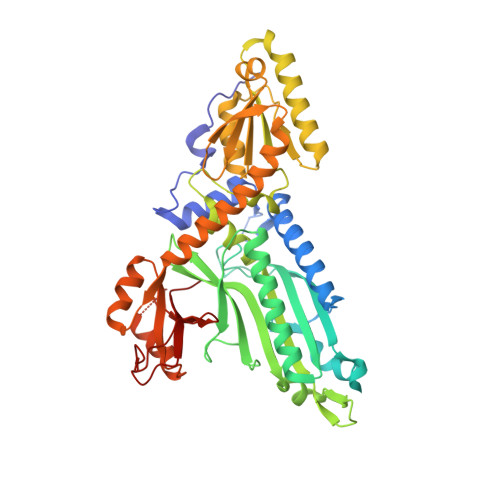Biochemical and Structural Characterization of Selective Allosteric Inhibitors of the Plasmodium falciparum Drug Target, Prolyl-tRNA-synthetase.
Hewitt, S.N., Dranow, D.M., Horst, B.G., Abendroth, J.A., Forte, B., Hallyburton, I., Jansen, C., Baragana, B., Choi, R., Rivas, K.L., Hulverson, M.A., Dumais, M., Edwards, T.E., Lorimer, D.D., Fairlamb, A.H., Gray, D.W., Read, K.D., Lehane, A.M., Kirk, K., Myler, P.J., Wernimont, A., Walpole, C., Stacy, R., Barrett, L.K., Gilbert, I.H., Van Voorhis, W.C.(2017) ACS Infect Dis 3: 34-44
- PubMed: 27798837
- DOI: https://doi.org/10.1021/acsinfecdis.6b00078
- Primary Citation of Related Structures:
4NCX, 4Q15, 4WI1, 5IFU - PubMed Abstract:
Plasmodium falciparum (Pf) prolyl-tRNA synthetase (ProRS) is one of the few chemical-genetically validated drug targets for malaria, yet highly selective inhibitors have not been described. In this paper, approximately 40,000 compounds were screened to identify compounds that selectively inhibit PfProRS enzyme activity versus Homo sapiens (Hs) ProRS. X-ray crystallography structures were solved for apo, as well as substrate- and inhibitor-bound forms of PfProRS. We identified two new inhibitors of PfProRS that bind outside the active site. These two allosteric inhibitors showed >100 times specificity for PfProRS compared to HsProRS, demonstrating this class of compounds could overcome the toxicity related to HsProRS inhibition by halofuginone and its analogues. Initial medicinal chemistry was performed on one of the two compounds, guided by the cocrystallography of the compound with PfProRS, and the results can instruct future medicinal chemistry work to optimize these promising new leads for drug development against malaria.
Organizational Affiliation:
Center for Emerging and Reemerging Infectious Disease (CERID), University of Washington , 750 Republican Street, Seattle, Washington 98109, United States.
















